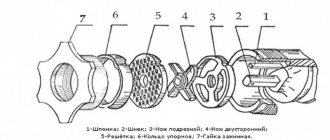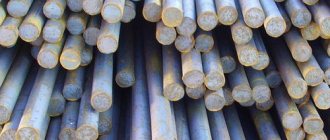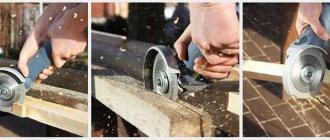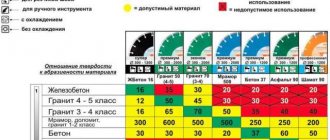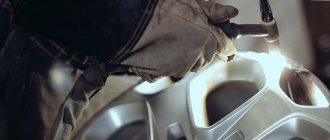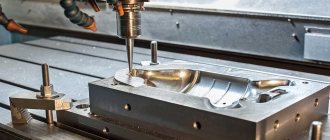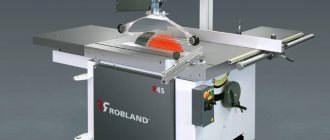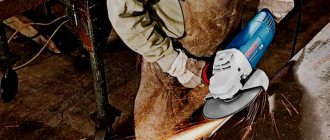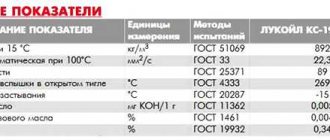An angle grinder or, as we are used to, a “grinder” is an excellent power tool that is available in the arsenal of almost any man. This device has many different functions, and with the advent of all kinds of additional attachments from China, the scope of its use has expanded significantly. Some examples of such products are available in the article “Practical attachments for grinders and screwdrivers”. You can get acquainted with it at this link. However, the main function of an angle grinder is cutting. In today’s article I will try to answer the question: “How to cut correctly with a grinder.”
Basics
For some, my tips and recommendations will not seem very useful and obvious. But you will be surprised that only half of the owners of grinders understand how to work with this tool. And those who adhere to safety precautions are even fewer. 57mm, f/4.6, 1/200s, ISO250, August 01, 2012)">
Selecting a grinder and disc
Before answering the question “how to cut correctly with a grinder,” you need to understand the angle grinder itself. Its choice and purchase should be based not only on the brand’s popularity and build quality. The initial parameter is its size. In my opinion, there should be two grinders. One is small for a 120 mm disc, and the second is large, for 230 mm. It doesn’t make sense to buy a medium-sized angle grinder, since you won’t be able to install a large disc, and it’s inconvenient to work with small products with such a power tool.
I advise you to read a very interesting article by my colleague, in which he talks in detail about how to choose an angle grinder and what nuances need to be taken into account. You can read it at this link.
Not only the speed at which metal can be released, but also safety depends on the quality of the disc. I advise you not to save on such consumables and purchase products from trusted manufacturers. I recommend using discs with a thickness of 1.2 to 1.8 mm. You can take thick 2.5 mm discs, but cutting them takes much longer. A 1.6 mm product is perfect for doing homework. The variety of grinder discs and their approximate cost can be found at this link https://www.220-volt.ru/.
Angle grinder
The grinder is a universal assistant that works great on aluminum.
It is only important not to confuse a cutting wheel with a grinding wheel, choose thin equipment to minimize material loss and protect your hands and face from sparks. Advantages:
- speed of work;
- decent cutting quality;
- relative cheapness of equipment;
- minimum user movements;
- durability of the equipment, which allows you to repeatedly saw metal profiles.
Angle grinder Sparky
Flaws:
- possibility of metal burning in the cut area;
- without working skills, it is unlikely that you will be able to cut smoothly;
- To increase the accuracy of the work, the grinder should be clamped into a stand, which is not supplied with the tool and is rarely found in stores (the problem is solved if you have a vice).
Now it’s worth studying special devices for working on aluminum.
To yourself or from yourself
The most common question that plagues many angle grinder owners is “how to cut correctly with a grinder so that the disc rotates away from you or toward you?” There are many opinions, and everyone proves their point of view. But there is only one correct answer: “you can cut both from yourself and towards yourself.” A clear proof of this is the presence of holes for the handle on both sides of the device. In general, it all depends on individual preferences; whoever is comfortable with it, cuts it that way. However, each method has certain nuances that should be taken into account.
Push
Many owners of grinders do not like and cannot even cut from themselves. The bottom line is that this method rarely forgives mistakes. Any inaccuracy or crooked cut leads to clamping of the disc and its rupture. I want to say that I have a friend who is used to cutting himself, and taking my grinder in his hands, he destroyed two discs and left screaming. This is a person who has been working with angle grinders for about 10 years. There is also a myth that when you cut away from yourself, if the disc jams, the grinder will fly into your stomach. I want to say that if you don’t hold it properly in your hands, then it can even fly away from the workshop. The advantage of cutting metal from yourself is that sparks fly from the grinder and it is possible to see the product better. In addition, if the disk ruptures, it will fly away from you.
To myself
Cutting metal with the blade turning towards you allows you to work with an angle grinder, excuse the expression, with a little negligence. But you pay for such convenience with sparks flying into your eyes and feet. If the protective cover is not positioned correctly, the risk of burning your pants increases exponentially. In addition, the product is much less visible, and if it ruptures, the disc can fly under your feet. When cutting metal using this method, I recommend holding the angle grinder in such a way that if the disc jams and ruptures, the latter cannot hit the leg or other part of the body.
Correct cut
Before you start cutting the product, you need to understand which side is best to do it on. If you have access from all sides, then this is very good, and the likelihood of making mistakes is reduced. Be sure to consider which direction the disk is spinning. So, when sparks fly from you, then under no circumstances make a “fork” when cutting a channel or metal profile. The photo clearly shows what I mean. You can’t cut like that with a grinder! When starting to cut metal, the grinder should be positioned so that the cutting part is slightly raised. You need to hold the angle grinder confidently, but when you start cutting metal, you should not put pressure on the product. Try to keep the device level. This way you will not only get an even cut, but also reduce the likelihood of the disc jamming. 80mm, f/7, 1/100s, ISO2000, June 30, 2021)"> The most important thing is to consider the basics of physics. The cut element should go to the side and not pinch the disk. It is best to create conditions so that it is suspended. To do this, place something under the product. Example in the photo. 6mm, f/2.8, 1/10s, ISO200, August 04, 2011)»>
Electric jigsaw
Before work, it is important to make sure that the tool is equipped with a file specifically for metal.
Of course, a wood blade will also cut aluminum, but the quality of the cut will leave much to be desired. The cutting of the profile begins from the back part, then the side edges are sawed in turn. Advantages:
- electrical equipment makes the user's work easier;
- quality close to ideal (the product will not have burrs, bevels, or other defects);
- speed of work;
- reusability (with the right choice of file);
- A jigsaw is cheaper than similar devices for cutting aluminum profiles.
Flaws:
- the workpiece must be securely fixed so that it does not “lead” when using the jigsaw.
Safety precautions
Safety precautions when cutting with a grinder are a way to protect yourself from injury and injury. Do not neglect the rules, the effectiveness of which has been proven in practice. Mandatory elements when working with an angle grinder are:
- safety glasses (pulling scale out of your eyes is not very pleasant, and no one wants to lose their sight);
- ear protection;
- gloves;
- Tight clothing that covers all parts of the body.
- Never cut metal without a protective cover. A ruptured disc can fly anywhere. In this case, neither glasses nor a mask will save you. Tests have shown that a ruptured disc can penetrate a motorcycle helmet. History remembers many tragic incidents, do not forget about them.
- Position your body so that it is not in line with the disc. Even if it breaks, it will fly past you.
- If you are cutting a metal product that is on the ground, then place the grinder between your widely spaced legs. Example in the photo.
Recommendations
- When cutting metal, the disc is not only worn around its circumference, but also its thickness is worn away. After replacing it with a new one, do not immediately go into the cut. This will lead to inevitable pinching and rupture of the disc. I recommend resuming cutting from the reverse side.
- There is such a nuance - the larger the disk, the greater its play will be. It's not about the grinder, but about the cutting element itself. Since its thickness is relatively small, it bends naturally. There is no way to rid yourself of such inconvenience. Just consider this fact.
- When cutting soft metals with a grinder, you should be extremely careful, since clamping of the disc in such products occurs much more often.
- Try to position the grinder in such a way that if the disc jams, it will not hit you in the forehead or stomach.
- When working with an angle grinder, you must be confident in what will happen in a second. If you don’t understand what could happen in the next moment, then it’s better to stop working and analyze the situation. There is no need to rush when working with an angle grinder.
- Start cutting metal only with a working grinder. That is, first turn on the device, and then come into contact with the product, and not vice versa. Securely tighten the nut holding the disc.
- Advice from me personally. If your discs jam, the cut turns out crooked, and the work generally doesn’t stick, then it’s better to just go and rest. Return to your work process with a fresh head and a positive attitude.
I hope my article today was useful and interesting to you. I tried to answer the question “how to cut correctly with a grinder.” How it turned out for me is up to you to decide.
I recommend everyone to read my colleague’s article “Do-It-Yourself Mixborder” . You can read it at this link .
Write in the comments how you rate your skills in working with an angle grinder, and what you can advise to a beginner who is just getting acquainted with an angle grinder.
I’ll be honest: I’ve never had to hold a grinder in my hands: its almost completely open cutting disc really scares me. But, Maxim, I’ll take note of your article in case I decide to acquire this very necessary tool for the household.
Sergey, to be honest, I don’t really like working with an angle grinder either. But I’m more afraid when someone else is cutting, and I’m standing in the zone of possible “defeat.” Somehow I don’t feel at ease...
For some reason, I am also chronically afraid of the “grinder”. I can’t calmly watch when someone is working with an angle grinder. And her husband and sons, no matter what they do, use her. I understand that it is a necessary and convenient tool. But mentally I wish for him to break, without the possibility of recovery. I read the article and realized that they are using it correctly, but I’m still afraid.
When I started learning to ride a bike at 3 or 4 years old, it was also scary. It was scary to ride an “adult” bike on my own for the first time. It took me several months to get used to the moped (I drove around Moscow). It was scary to confess your love to a girl for the first time... The second time was also scary, but the third and fourth time I was more confident, because in the first two cases I was refused (and learned to stand away from a flying disk of large diameter at high speeds). In order to learn how to work with an angle grinder and not be afraid of it, I consider it advisable to use the tactics of “small steps”. Step one: Turn on the angle grinder without the disc installed. Hold it in your hands while it is turned on, make several small and slow movements with the tool - you will feel that the turned on motor in this case is a “gyroscope”, like a rotating bicycle wheel. Repeat this exercise several times intermittently. Let your hands get used to the handles and switches. Step two. Place the cutting disc on the grinder and turn it on. Imitate the movements you would make when working with the material. Turn off the grinder. Place it on the table after the disc has stopped completely. Repeat these steps 5 times. Step three. Clamp a piece of 6 or 8 mm wire in a vice on a workbench (never with your foot on a stool). Using a grinder with a cutting disc installed, cut the training pieces from the wire. Stop the exercise when you are confident that you have learned how to cut the wire. Step four. Replace the 6 mm wire with 10 or 12 mm reinforcement. Cut the reinforcement into pieces until your hands feel tired. Step five. Secure a 20x20mm metal angle or a piece of steel pipe with a diameter of no more than an inch (2.5mm) in a vice. Cut, train, get used to it. The feeling of “fear” gradually goes away along with the pieces of metal falling off. Don't rush or put pressure on the instrument. Step six. A metal corner 40x40 or a metal pipe as thick as your hand. You already know what to do. The most important thing is to keep the cutting line vertical when cutting. Step seven. You're almost a professional. Proceed to cutting channels and I-beams. For your spouse who is afraid of the grinder, teach him how to remove burrs from your perfectly cut workpieces using a file. Maybe time will pass, her fears will go away and she will want to work with a chainsaw in the garden... Advice: Don’t rush to become a professional in one day.
Easy methods for smooth cutting of metal sheets with a grinder
Angle grinders (angle grinders) or, as they are popularly called, grinders, are the most common power tool both in home workshops and in industrial production. Thanks to the use of this power tool, it is possible to process the surface of hard materials (polishing, grinding) in a short period of time.
Angler grinders are often used for cutting a variety of metal products. It is worth noting that, despite the ease of performing work associated with this power tool, not every user is able to make an even cut on sheet metal using a grinder. At the same time, there are a large number of easy methods for evenly cutting metal sheets with a grinder.
Saws
A circular saw
Similar to a hand saw, but more powerful. Has the following capabilities:
- performs longitudinal, transverse, oblique cuts;
- can cut from any place on the workpiece (not just from the end);
- modern devices prevent overheating by turning off in a timely manner or sending a signal to the operator;
- The user can select the operating speed based on the thickness of the workpiece.
Advantages:
- durability of the equipment - a disk for working on metal (preferably on aluminum);
- speed of work;
- maneuverability;
- the ability to cut at an angle of up to 45 degrees;
- cost comparable to more suitable analogues (miter saws for aluminum).
Flaws:
- as a rule, the equipment is bulky and weighs a lot, which complicates the work;
- the price will seem high if the tool is purchased for one-time work;
- the cost varies depending on the permissible thickness of the profile being cut (for example, the Evo 180 manual circular saw cuts profiles up to 56 mm at an angle of 90 degrees and up to 35 mm at 45 degrees; it costs almost 25 thousand rubles).
Circular Saw
As an example, we consider the Yilmaz KY 305 table saw machine. This is a special device for cutting small-section metal profiles with small wall thickness.
A mechanical clamp fixes the workpiece, the cutting angle is set to 45 degrees (in any direction), it is possible to select a fixed angle (0, 15 degrees, 30 degrees, etc.). Advantages:
- allows you to cut larger workpieces (up to 130x65 mm);
- compactness;
- possibility of angular cutting;
- high speed and accuracy of work;
- accessibility of equipment (saw blade 300 mm).
Flaws:
- high cost (an average installation costs 40-50 thousand rubles);
- is not compact and light.
How to cut thin sheet metal smoothly
To quickly and accurately perform work related to cutting sheet metal, you need to choose the right power tool such as a grinder. To cut thick or thin sheets, you need to select an angle grinder of appropriate power, as well as the diameter of the cutting wheel. In addition, when purchasing, it is recommended to pay attention to the functionality of the power tool (the presence of a soft start system, regulation of the disk rotation speed).
For everyday home use, if there is a need to cut thin metal, ordinary low-power grinders (up to 1 kW) are suitable. However, to cut thick sheets, it is preferable to purchase powerful angle grinders (from 2 kW), which are equipped with a soft start system. There are several types of grinders, differing in both scope and functionality. Such power tools are:
- professional type;
- semi-professional type;
- household;
- with one or more handles;
- with a soft start system and a self-speed control mechanism.
In addition, there are angle grinders of medium, low, and high power. Such a power tool can be used both for cutting metal and other hard surfaces (concrete, stone). Angler grinders are often used to perform a variety of jobs related to cleaning, grinding, and polishing working surfaces.
To cut sheets of small thickness, you can use a low-power grinder, the power of which is about 0.6-1 kW, with a disk diameter of 125 mm.
To accurately and evenly cut thin sheet metal, the thickness of which is about 1 mm, you need to be extremely careful and attentive. After all, when processing such materials using an angle grinder, the cutting disc can “bite”. Therefore, before carrying out work, you should inspect the cutting disc and make sure that there are no defects or chips on its surface.
Features of aluminum processing
Cutting soft metals raises many questions among ordinary people. In particular - aluminum. To process such material, there is a wide variety of sawing attachments that have different diameters. They also produce wheels for grinding aluminum. The description of cutting wheels for an angle grinder must begin with their sizes.
If we talk about aluminum, then for its processing we use circles with a thickness of about 1 mm. This choice is explained by the fusibility of this metal. When working with a thick nozzle, aluminum becomes viscous from friction and begins to clog the abrasive wheel with its particles. In such a situation, the disc simply stops cutting.
As for the configuration and coating of the cutting part, most often wheels for aluminum have a fine diamond coating and a cutting edge in the form of several sectors. Essentially, this is a saw blade for concrete. It is convenient for them to carry out work on cutting aluminum structures. For example, cutting a profile. The diameter of such a disk has a minimum value, that is, 12.5 cm.
Circles with a maximum diameter of 23 cm are most often multifunctional and cut not only metals, but also concrete, plastic pipes and even wood with nails.
How to cut thick sheet metal smoothly
To cut thick sheet metal, it is advisable to use a grinder with a power of more than 1 kW. In this case, you need to cut the product using an angle grinder in the direction forward from its edge. First, you need to draw a line on the sheet along which the cut will be made. Then along the drawn line you need to place a steel corner or a flat wooden beam. Using clamps, the corner (beam) is firmly attached to the surface of the sheet.
Then, along the corner, strictly along the drawn line, you need to walk the angle grinder and make a small groove, the depth of which is about 1-2 mm. After completing this procedure, the angle can be dismantled and normal metal cutting can begin.
A groove made on its surface, along a marked line, will not allow the saw blade to move away from a predetermined trajectory, resulting in perfectly smooth edges at the cutting sites.
Also during work, it is necessary to take into account the direction of rotation of the grinder circle, as well as its size. You cannot install large discs (from 150 mm or more) on small angle grinders (125 mm) after first dismantling the protective casing.
Methods for cutting aluminum profiles
Conventionally, all methods are divided into two groups:
- cutting with compact manual or electric equipment;
- cutting with special devices (portable or stationary).
Cutting aluminum on a machine
The first group includes the following tools:
- hacksaws for metal;
- metal scissors;
- jigsaws;
- Bulgarians.
The second category includes:
- plasma, laser, milling installations;
- various saws.
Now it’s worth studying the features of each method, advantages and disadvantages, and then draw a conclusion about the best method for cutting aluminum profiles.
Why is it dangerous to cut aluminum with a grinder?
Cutting aluminum is not only difficult, but also unsafe! Especially when using a high power grinder. Due to the viscosity of aluminum, the disc will get stuck and the tool will try to pull out of your hands.
And this will not happen immediately, but only when the cut reaches a certain depth. And this may come as a surprise to an inexperienced user of the tool. And in general, with a disk stuck in the metal, cutting will not be easy.
A short story about how I had to cut an aluminum tank. And what came of it
One of my friends once had a job delivered to him and needed to saw an aluminum tank with a grinder. “It’s a piece of cake,” he thought—cutting aluminum, there’s nothing easier!
But his joy quickly disappeared when he got down to business.
The disk constantly got stuck, stuck in this metal. The Bulgarian woman tried to jump out of her hands. Sawing was a pain; it went very slowly. Various abusive thoughts did not leave my head. )))
So what to do? I got to work - I need to do it! So several hours of hard work passed. An old man passing by came to the rescue.
Seeing the torment, he began to try to give advice, but advice is sometimes difficult to accept, especially when his nerves are already at their limit. After all, the work, which seemed simple at first, was already pretty exhausting. Therefore, the first reaction to advice is the desire to send him to hell.
Nevertheless, the advice was given and in the end, as the friend said, he followed it. Imagine his surprise when after that things went much more fun.
What was the tip that helped you cut an aluminum tank easily?
And the advice was as follows. The cut area needs to be lubricated. For example, used automobile oil is quite suitable for this purpose. A little practice, and the work began to boil. The disc did not get stuck, aluminum was cut with a bang. So, a simple trick from an experienced person helped save both nerves and strength. And perhaps health, since the grinder stopped getting stuck in the aluminum and trying to escape from my hands. You understand the dangers of such a situation when working with this tool. Don't believe me? Talk to surgeons, they will tell you.
Metal scissors
The tool is convenient and easy to work with aluminum. Sheets of metal are pre-marked.
The disadvantages of working with scissors include:
- the need for training before finishing metal cutting. A person without experience will not perform the action exactly along the marking lines;
- Due to the structural features of the profile, there is a high probability of deformation of the product or an uneven cut.
There are special cutting shears for aluminum, but they are not suitable for cutting profiles; you should give preference to the classic version Source Artem-tools.ru
